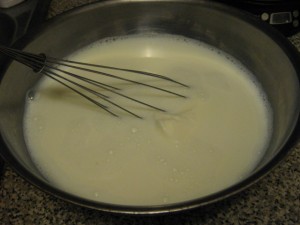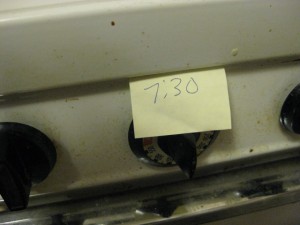
Homemade Yogurt
Yes, I make my own yogurt from scratch. No, it is not time-efficient! But I love the ritual of it, and I also love knowing that I am one step closer to running a dairy farm out of my Tuscan villa during vacations from traveling the world saving babies. Depending on the type of milk I use, I actually end up saving quite a bit of money, too. (When I have an income, I buy my milk from the farmers’ market, and that definitely does not save me money … but it’s worth it for the local-organicness of it all.)
A few basic requirements for making yogurt my way:
– an oven with a pilot light (If your oven does not have a pilot light, it won’t be the right temperature for incubating the yogurt.)
– a stainless steel half gallon double boiler, or something that passes for one (I balance a big stainless steel bowl on top of a giant pot.)
– a dairy thermometer (or any liquid-safe thermometer that displays temperatures between 90 and 180 degrees)
– clean glass jars with lids for incubation (I use empty applesauce jars.)
– an uninterrupted overnight span of 8-14 hours
Ingredients
– half gallon milk (I buy skim by the gallon and process it in half gallon batches for increased cost-effectiveness.)
– 1/4 to 1/2 cup room temperature starter culture (This can be freeze-dried cultures or already-existing yogurt, either from your last batch or store-bought. When I don’t have yogurt from my last batch available, I start fresh with a combination of yogurt from Stonyfield Farm and Ronnybrook Farm Dairy because they contain the best variety of cultures I have found.)
Process
1. Heat milk in double boiler until temperature reaches 175-180 degrees. I stir the milk a bit throughout the heating with a stainless steel spoon to ensure that it doesn’t boil or form a skin on top.


2. Remove bowl from pot and place on a surface away from heat. Cool until temperature is between 90 and 110 degrees, about one hour.
3. Use a stainless steel whisk to mix starter culture into milk.

4. Pour milk/culture mixture into a glass or stainless steel container with a pouring spout.

5. Pour into clean glass jars, cover, and place in OFF oven.

6. Close oven door. I usually stick a post-it over the oven knob to remind me (and everyone else) when the yogurt went in and that the oven is off-limits.

7. Go to sleep for 8 – 14 hours while the yogurt incubates (I have had the best luck quality-wise with 10 hours). When you wake up, remove the yogurt from the oven and refrigerate it. You’ll be so excited and surprised when you see that you actually have yogurt and not rancid milk. (I do this one to two times per week, and I have never had rancid milk waiting in the morning!)
8. Optional: If you plan to do this again within the next week, immediately spoon out some of your yogurt to reserve in a refrigerated container so that you have a carefully protected starter culture when you are ready.
9. Optional: Follow procedure for Greek yogurt if you like a thicker texture.

Thanks for this! Unfortunately, I don’t think my oven has a pilot light 😦
Yesterday, I finally went to the health food store that is 2 blocks away from me on Court Street! They had your Celestial Seasonings holiday tea for $2.49 a box (they had a ton and I got 3 different varieties) and Lara bars on sale for 2 for $3.
LikeLike
Oooh, what’s the name of the store? Did they have the sugar cookie tea? Mmmm, I need to get over there!
If you really want to make yogurt, you don’t necc need a pilot light in your oven — just a way to keep it around 100 degrees. I’ve never tried it any other way, but there are several alternatives. From http://www.wikihow.com/Make-Yogurt :
– If your oven doesn’t have a pilot light but does have an oven light, preheating the oven to the desired temperature, turning it off, and then leaving the oven light on to maintain the temperature. Another method is to turn your oven on and then off again periodically. Be careful that it doesn’t get too hot. To check the oven temperature, you can put your candy thermometer in a bowl of water inside the oven.
– Other methods for keeping the yogurt warm are: hot water in a sink, a stove burner, a crock-pot, a warming tray, a large thermos, a heating pad, a sunny window, in your car on a sunny day, etc. Just use your thermometer and best judgment.
LikeLike
I’ll have to try this – thanks!
LikeLike
Hey Len! I just wanted to say that I have followed this yogurt recipe 4 times and also feel strangely satisfied by the process. I wanted to share a recipe that I made a few weeks ago that was absolutely delicious…I am not sure if a link will work on here but it can be found on Women’s Health Magazine site and is for Moroccan Stewed Chicken. Try it out!
LikeLike